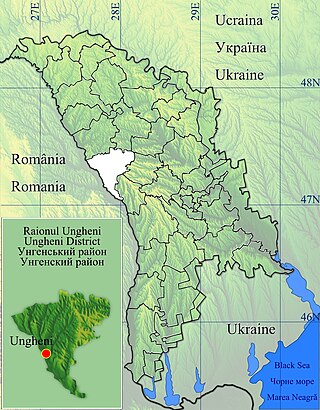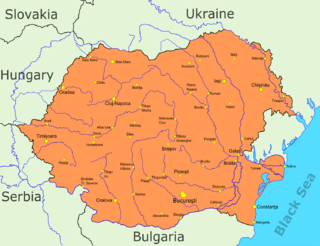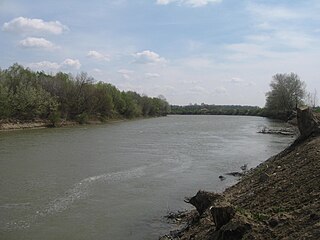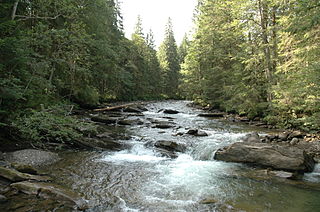Reactions
-
 At the request of Mikhail Gorbachev, French President François Mitterrand asked by phone his Romanian counterpart not to commit any imprudence. [11]
At the request of Mikhail Gorbachev, French President François Mitterrand asked by phone his Romanian counterpart not to commit any imprudence. [11]
| Native name | Podul de Flori |
|---|---|
| Date | 6 May 1990 June 16, 1991 |
| Time | 1–7 p.m. |
| Location | Romania–Moldavian SSR border |
| Organized by | Cultural league for the unity of Romanians everywhere Bucharest–Chișinău Cultural Society Popular Front of Moldova |
| Participants | 1,200,000 (1990) 150,000–240,000 (1991) |
| Footage | Dailymotion |
The Bridge of Flowers (Romanian : Podul de Flori) was a massive demonstration that took place on Sunday, 6 May 1990 along the Prut River separating Romania and the Moldavian SSR. [1]
The first event took place on 6 May 1990. During this action, inhabitants of Romania were allowed that day, between 1 and 7 pm, to cross the Prut River in the Moldavian Soviet Socialist Republic without passports and visas. [2] Along the Romanian-Moldovan border of 700 km (430 mi) on the Prut, eight checkpoints were created: Miorcani–Pererita, Stânca-Costești, Iași–Sculeni, Ungheni–Ungheni Bridge, Albița–Leușeni, Fălciu–Țiganca, Oancea–Cahul and Galați–Giurgiulești. [3]
Inhabitants from both sides of the border, which had been tightly enforced since World War II (for two decades prior to which much of Moldova had been part of the Kingdom of Romania), gathered on each bank, many crossing what had been described as a watery Berlin Wall to see family members long separated by the frontier. [4]
The number of participants has been estimated at 1.2 million people. [5] At Ungheni, approximately 250,000 crossed the border. [6] The demonstration organized by the Cultural League for the unity of Romanians everywhere, [7] in collaboration with the Bucharest–Chișinău Cultural Society and the Popular Front of Moldova, began early in the morning as thousands appeared on the Romanian side with armfuls of flowers. Participants began throwing flowers into the water that soon covered the surface of the river, symbolically creating a bridge between the two sides. At noon, a group of priests celebrated a Te Deum , [8] after which church bells on both sides rang for a long time. Then, more flowers were thrown into the river and meetings on the bridge began to take place. Speeches, slogans and appeals were absent. Popular music and games, festive meals and similar activities followed, with the event wrapping up around 6 pm. [8]
After this action, the procedures of crossing the Romanian–Soviet border were simplified considerably. [9]
The second Bridge of Flowers took place on 16 June 1991. This time, the inhabitants of Moldova were able to cross the border without papers into Romania. According to a report released by Rompres, more than 150,000 people from Bessarabia crossed the border at Sculeni into Iași County. [10] Among them was a delegation of Members of Parliament of the Republic of Moldova led by Nicolae Costin, the Mayor of Chișinău. [10]
In Galați, in front of the Precista Church, arose on this occasion a crucifix symbolizing the union. This 1991 version of the Bridge of Flowers saw a similar number of people who attended the first Bridge of Flowers in 1990.
This day could be a nice revenge for the fateful day of May 16, 1812, when the body of Moldova was mangled by Russia under Tsar Alexander I, as of June 28, 1940, when Stalin cut to pieces the map of Greater Romania. Our meeting with the Bessarabian brothers proves, once again, that we are one people, speaking the language of Eminescu, in the space between the Prut and the Dniester and that the Union today, which lasted only six hours, will be just a prologue of final reUnion.
— Mircea Cosma, Chairman of the Prahova County Council, Ziarul Prahova
In terms of foreign policy, this event has been translated by establishing a priority for Romania to bring Moldova within the united Europe. Thus, flowers thrown 20 years ago in the Prut will find their meant shore.
It was an indescribable emotional tension. People shouted and called each other and rediscovered after years and years. At one time, on the other side of the river a man jumped into the water and began to come to the Bessarabians on the other side. My locals from Pererâta stayed speechless. They had great emotions and did not dare to make any move until a villager from Pererâta jumped into the water. After him started others. They met all in the middle of the Prut and made there, in the water, a horă, thing unseen and unheard elsewhere in the world. This is why I say that those who mock the Bridge of Flowers seem ridiculous. The tear of joy can not be bantered.
The tens of thousands of Romanians on both sides pealed like a river. Romanians (west of the Prut) were the first who entered the USSR without permission.
— Ion Ungureanu, Minister of Culture and Religious Affairs of the Republic of Moldova (1990–94), Ziare.com

Ungheni is a municipality in Moldova. With a population of 35,157, it is the seventh largest town in Moldova and the seat of Ungheni District.

Ungheni is a district in the central part of Moldova, bordering Romania, with the administrative center at Ungheni. The other major city is Cornești. As of 1 January 2011, its population was 117,400.

The unification of Moldova and Romania is the idea that Moldova and Romania should become a single sovereign state and the political movement which seeks to bring it about. Beginning during the Revolutions of 1989, the movement's basis is in the cultural similarity of the two countries, both being Romanian-speaking, and their history of unity as part of Greater Romania.

European route E 58 is a road part of the International E-road network. It begins in Vienna, Austria, and passing through Slovakia, Ukraine, Romania and Moldova, ends in Rostov-on-Don, Russia. It is approximately 2,200 km (1,400 mi) long.

The A8 motorway, also known as The Union Motorway or the East-West Motorway is a planned motorway in Romania, that will cross the Eastern Carpathians to connect the historical regions of Moldavia and Transylvania. It will directly link the cities of Iași and Târgu Mureș. The A8 motorway route is an integral part of the Trans-European Transport (TEN-T) Core Network.

Ungheni is a commune in Iași County, Western Moldavia, in eastern Romania, part of the Iași metropolitan area. It is composed of four villages: Bosia, Coada Stâncii, Mânzătești and Ungheni.

The Republic of Moldova–Romania border is the international border between Republic of Moldova and Romania, established after the dissolution of the Soviet Union. It is a fluvial boundary, following the course of the Prut and Danube. The boundary is 681.3 kilometres long, including 570 metres (1,870 ft) along the Danube.

Andrei Eșanu is a historian, writer and researcher from the Republic of Moldova. He is a member of the Commission for the Study of the Communist Dictatorship in Moldova. He is part of the Academy of Sciences of Moldova, and was elected an honorary member of the Romanian Academy in 2011.
Anatol Petrencu is a politician, historian and academic from the Republic of Moldova. In 1990-1992 he was the dean of the Faculty of History of the State University of Moldova, and between 1998 and 2006 he was president of the Association of Historians of Moldova. Between 2006 and 2010 he was the president of the European Action Movement party. Since October 2010 he has been the director of the Institute of Social History "ProMemoria". Vice President of the Liberal Party.

The Eiffel Bridge is a bridge over the River Prut and a checkpoint between Moldova and Romania. The bridge is located between Ungheni, Moldova and Ungheni, Romania.

Ion Țurcanu is an author, educator, historian, memoirist, professor, former member of the Parliament (1990–1994), politician and Romanian writer from Moldova. He is one of the 277 MPs of the first parliament of the former Soviet Socialist Republic, who voted for the Declaration of Independence of the Republic of Moldova on 27 August 1991.

The Prut is a river in Eastern Europe. It is a left tributary of the Danube, and is 953 km (592 mi) long. Part of its course forms Romania's border with Moldova and Ukraine.

The Centenary March or Centenary March of the Great Union was a civic demonstration organized by George Simion and various non-governmental organizations from Romania and Moldova, known under the collective name "Alliance for the Centenary". It started in Alba Iulia (Romania) on 1 July 2018 and ended in Chișinău (Moldova) on 1 September 2018. Its participants, both Moldovans and Romanians, targeted 300 cities and villages, passing through several points significant for the Great Union.

Greater Moldova or Greater Moldavia is an irredentist concept today used for the credence that the Republic of Moldova should be expanded with lands that used to belong to the Principality of Moldavia or were once inside its political orbit. Historically, it also meant the unification of the lands of the former principality under either Romania or the Soviet Union. Territories cited in such proposals always include Western Moldavia and the whole of Bessarabia, as well as Bukovina and the Hertsa region; some versions also feature parts of Transylvania, while still others include areas of Podolia, or Pokuttia in its entirety. In most of its post-Soviet iterations, "Greater Moldova" is associated with a belief that Moldovans are a distinct people from Romanians, and that they inhabit parts of Romania and Ukraine. It is a marginal position within the Moldovan identity disputes, corresponding to radical forms of an ideology polemically known as "Moldovenism".

Currently, there are three defined types of public roads in the Republic of Moldova:

"Bessarabia, Romanian land", "Bessarabia is Romanian land" or "Bessarabia is Romania" is a popular and commonly used Romanian nationalist and irredentist slogan posing claims over the geographical region of Bessarabia, today divided between the Republic of Moldova and parts of Ukraine. According to the Romanian newspaper Adevărul, the use of this slogan as a patriotic catchphrase started in 2006 from a group of anonymous young Romanians from Bucharest.
Since 2018, there have been proposals for the building of a motorway in Moldova between Ungheni and Chișinău, and from there to the border with Ukraine towards Odesa, as an extension of the Romanian A8 motorway from its eastern terminus near Iași. The total cost of the project is 1 billion euro, for a total length estimated to be at around 220 km (140 mi). The motorway would serve as an extension to the future motorway corridor Iași–Cluj-Napoca–Budapest–Vienna–Munich.

Action 2012, officially Unionist Platform Action 2012 or Civic Platform Action 2012, is a coalition of non-governmental organizations striving for the unification of Moldova and Romania operating in both Moldova and Romania. It was established on 17 April 2011, bringing together more than 30 unionist NGOs from Romania, Moldova, the United States and several other European countries. Action 2012 takes its name from the year 2012, which marked the 200th anniversary of the annexation of Bessarabia by the Russian Empire away from the Romanian principality of Moldavia. The coalition was founded by George Simion, then a Romanian activist who later became a politician.

In 2018, over a hundred localities in Moldova and dozens in Romania issued symbolic declarations of unification with the other country. Such declarations were also issued by some Moldovan districts and Romanian counties, members of the Moldovan and Romanian diasporas and other non-territorial entities.